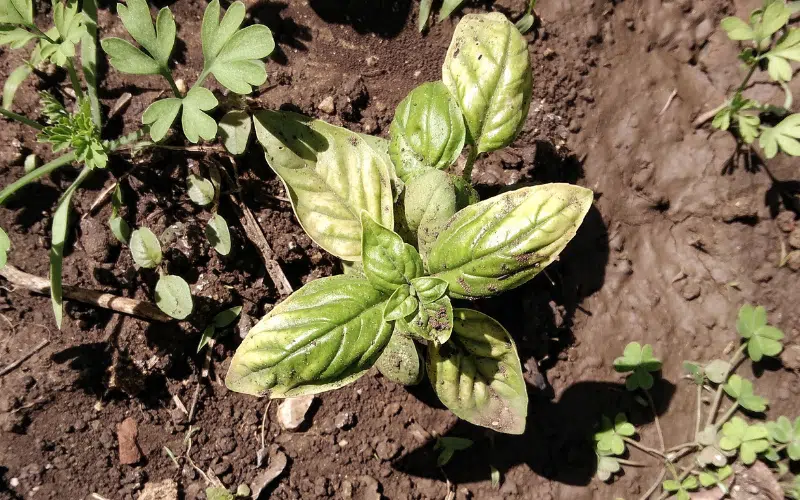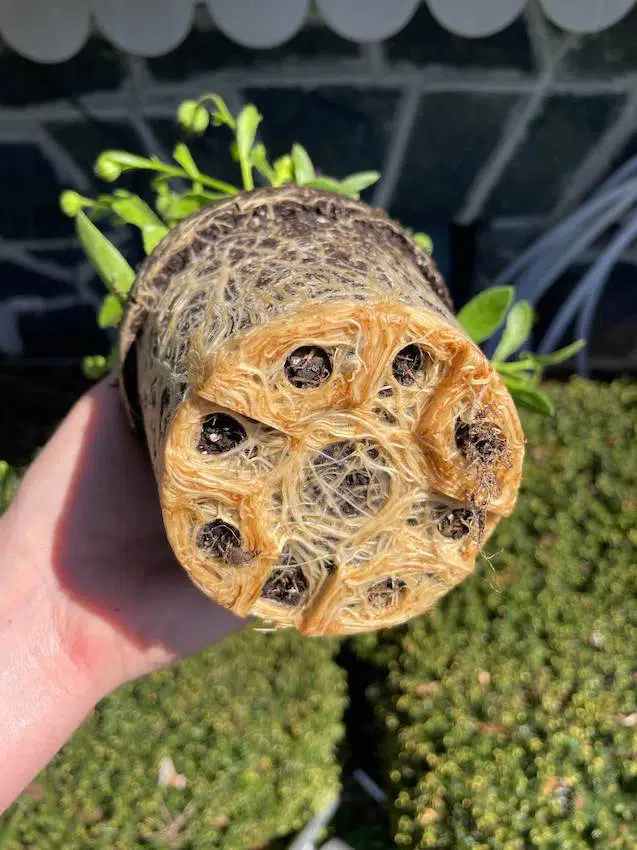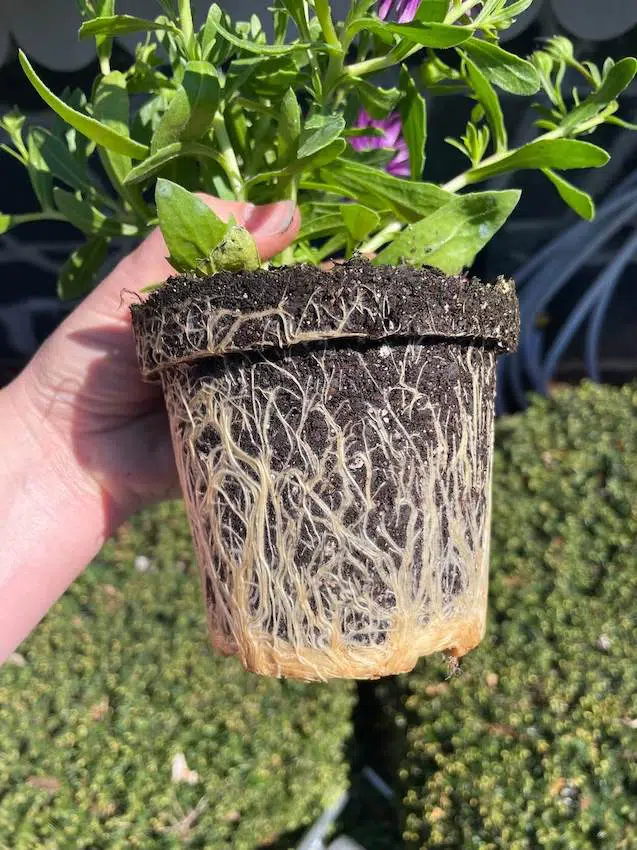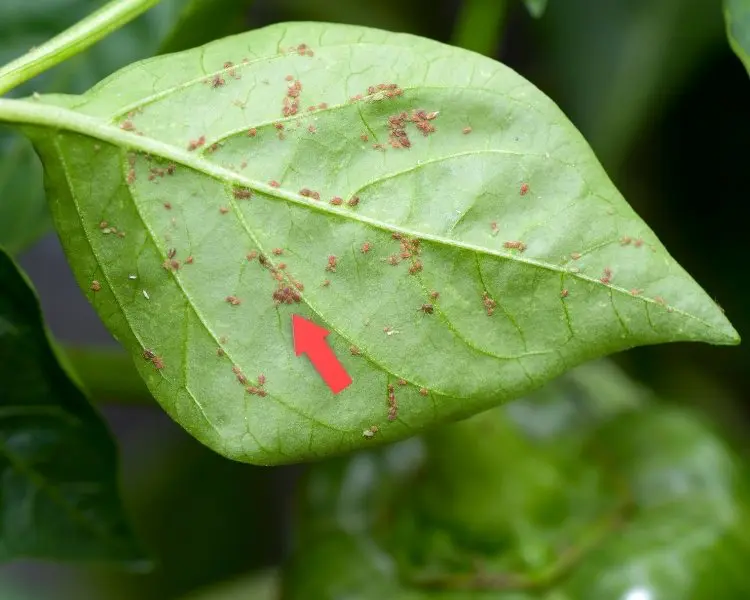Basil is a great herb to get started with as a gardener. It can be grown in almost any outdoor or indoor garden.
Between sweet basil, Thai basil, and large leaf Italian basil, there are plenty of basil varieties to be excited about growing.
But there are a few common issues that come up when growing it, and one of the big ones is basil leaves turning brown.
Why is Your Basil Turning Brown?
Let’s start with the basics. All plants need 4 things to grow big and strong:
- Water
- Light
- Heat
- Oxygen
When you don’t provide enough of these, or give too much of any of those four you can run into problems and end up with a not-so-green plant.
The most frequent problems are not enough (or too much) water, not enough light and heat, fungal disease, and pests. If you can keep these at bay, you should end up with bright green basil leaves and healthy basil plants that provide a great harvest.
But if you keep those four plant requirements in mind, you can avoid quite a few of these issues.
8 Common Reasons Your Basil is Turning Brown
With those four basics in mind, here are some of the most common reasons for leaves to turn brown.
1. Overwatering
Overwatering is a very common issue for indoor plants. When people get started gardening, they think you have to water every plant every day. That’s just not the case and often ends up with the plant getting too much water.
When basil plants are outdoors, even if it rains a lot, there is a great drainage system known as Mother Earth that will help move the water away from plants.
In an inside garden, plants just end up sitting in the water and can end up with root rot.
Oxygen is a necessity for plant roots, and if they’re sitting in soil, they will effectively be drowning and not able to get that oxygen. Basil needs oxygen.
Overly damp soil sitting around for long periods of time can also attract fungal diseases like fusarium wilt and downy mildew.
How to Fix It:
Before watering your basil plants, check the soil with your finger. Instead of just testing the top of the soil, check about an inch into the soil and make sure the roots aren’t still damp. If they are damp, you can likely skip watering the plant that day.
Often times the soil on top seems bone dry but the soil below the surface is still wet. You might think your basil plants need water, but this can end up causing browning of the leaves.
2. Not Enough Water
While this issue generally causes basil leaves to wilt or turn yellow, they can end up turning brown as well if they’re too dry.
Make sure you’re using the finger test (from above) and checking the soil below the surface to make sure it has enough moisture.
If the soil beneath your basil feels dry, go ahead and water your plant.
If it’s damp or wet, skip that day and try it again tomorrow. Your basil will thank you!
3. Not Enough (Or Too Much) Sunlight
Basil plants need 6-7 hours of sunlight each day. Without enough light, they may start to wilt or show signs of discoloring leaves (yellow or brown).
On the flip side, too much sun can harm the plant as well. If you leave your basil plant in direct sunlight (full sun) for 10 or more hours, you may end up with black or brown spots on your basil leaves, which is kind of like sunburn for a basil plant.

How to Fix It:
If you live in a place where you just can’t get that much light through the day for your basil, it might be time to look at indoor grow lights. These can help you regulate the amount of sunlight your plants are getting.
If your plants are outside and getting too much sun and heat, try using a 20-40% shade cloth to help keep some of the heat off of your plants. Prune basil leaves that have turned yellow/brown.
4. Running Out of Space
Basil needs a certain amount of space to spread its roots and be able to grow healthily for a long time. If you leave it in the same seedling tray it was started in, it won’t have enough space to grow.


When the pot isn’t large enough, your basil plant could end up being “rootbound,” which means the roots grow in circles and end up suffocating each other. Poor basil!
If you notice your basil roots starting to grow out of drainage holes or the soil is drying out very quickly after being watered, this is likely the cause.
How to Fix It:
Get a new, larger pot and transplant your basil plant into it. It’s that simple.
Use a pot that is at least 8-10 inches deep. This promotes root growth and will help you avoid basil leaves turning brown.
Make sure the new pot has drainage holes to help your basil growing healthy and avoid root rot.
Gently massage the basil roots to let them expand and start the process of growing, but don’t do this too much as you can do more harm than good.
5. Not Enough Heat
This is a common one for all of you indoor basil growers.
Basil plants prefer to be in an environment that is between 77 and 85 degrees F. If your basil plant is left in a place that is under 60-65 degrees F, after a few days the basil leaves will start to discolor.
How to Fix It:
Consider using heat mats to keep your basil plant in a good temperature range. The best seedling heat mats come with thermostats to allow you to control the temperature and make sure it’s staying within range and not getting too hot or cold.
This was a game changer for me and allowed me to grow my veggies from seeds in about half the time they did otherwise. Having the proper temperature is a very important factor for growing healthy, green basil plants.
6. Pests and Bugs
Oh the joy of gardening – dealing with weird bugs you never knew existed!
Aphids, mealy bugs, scales, and spider mites are three common pests you might find on your basil leaves.

Aphids are frequently found in the garden, and can be a pain to get rid of.
I call them the glitter of gardening, because they multiply like crazy. You might have 4 one day, and then next see 600.
They’re also super hard to get rid of completely, and often end up returning. Aphids look like tiny specs on the bottom of your basil leaves, and can be almost any color of the rainbow.
There are some companion plants for basil you can plant nearby to deter aphids and other pests.
It’s wise to do a spot check regularly to make sure you don’t have an issue. It’s best to catch this sooner than later to avoid a complete infestation.
While they generally won’t cripple the entire plant, you will find some browning basil leaves or brown spots where they are sucking out vital nutrients and water. You may even see some holes where a pest took a bit out of the basil plant.
How to Fix It:
My favorite way to fix a pest issue is by using diatomaceous earth. It’s an organic matter that bugs hate but doesn’t not hurt your plant. You don’t need much, but it’s very effective.
This stuff will deter ants as well, so if you’re experiencing a problem with pests on your plants than it might be worth a shot!
Another method you can use is to spray insecticides (organic and natural of course!) on the plant.
Commonly, you’ll hear that predatory insects can help get rid of pests like aphids, but when you’re growing basil indoors you don’t really want to add MORE bugs to the system – even if they are cute lady bugs.
7. Disease and Fungus
While they are typically strong plants, basil can suffer from quite a few diseases and fungi. Here are some common ones you might experience when growing basil:
Fusarium Wilt / Fusarium Oxysporum
If your basil leaves are turning yellow and then brown and look like they’re drying out, you could be experiencing fusarium wilt. Check for brown streaks and spots along the stems. This one is a doozy, and requires you to get rid of the entire plant.
Colletotrichum
This disease causes basil plant leaves to look like they are slowly burning like they were left over a flame.
Downy Mildew
If the basil plant the top of the leaves turning yellow, and a grayish/brown looking fungus on the bottom of the leaves, it’s likely downy mildew. It kind of looks like a moldy cobweb.
Fungal Leaf Spot / Cercospora Leaf Spot
Usually presents itself as brown spots with white or gray in the middle. This looks kind of like ringworm for plants, but it’ll be brown on the outside ring.
Damping Off
If your plant appears to be rotting from the stem upward, it could be this soil borne fungal disease. If this happens, you’ll need to get rid of the plant completely (and not put it in your compost pile) as well as the soil. Keeping the soil for future use will almost ensure these problems will happen again. It’s better to just go get some new soil and not chance it.
While some of these problems are not generally the gardener’s fault, a great way to avoid disease on your plants is to avoid watering them too much or watering them at night. By watering your plants properly in the morning, you give them time to use some of the water so it doesn’t sit around the soil encouraging fungal diseases to creep in.
Quite a few of these diseases are so robust, that you’ll want to get rid of the plant immediately (and NOT put it in the compost bin). You might end up contaminating the entire compost pile, which would stink a lot!
8. Overhandling
Basil can become too stressed if you are repotting it frequently. This can result in brown or yellow leaves, wilting and stunt the growth of the basil plant.
If you do need to put your basil in another container, make sure you give it some time to adapt to the new environment before changing it’s container again.
While basil is a pretty tough plant, it is subject to a few issues and disease (as with anything in the plant world). Fusarium wilt and downy mildew are the more common diseases and can wreak havoc on your plant, so make sure to keep an eye for those.
Here is a great resource if your plant has basil leaves turning yellow instead of brown.


